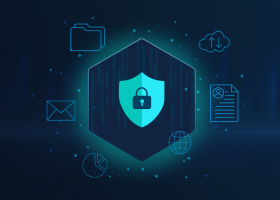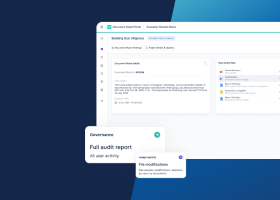Virtual Data Room Guide
Note to reader: This Egnyte Governance Guide outlines the general capabilities and benefits of Virtual Data Room solutions. If you’re looking for specific information about Egnyte’s Document Room solution, you can find it here. Virtual data rooms are commonly used as collaborative digital data repositories. Often, this controlled environment is used as a space where confidentiality can be preserved, and information can be easily shared. Information is accessible when required, but it is guarded to protect it from unauthorized access.

Organizations use virtual data rooms to gather a multitude of documents and files, most of which contain sensitive data that must be kept private with limited access to outsiders. Information stored in virtual data rooms can include data regarding financial records, tax receipts, legal issues, copyright certificates, trade secrets, and competitive bid information.
Because they are used to hold an organization’s most sensitive data, virtual data rooms are typically restricted to an organization’s most trusted employees and user visibility to data needs to closely managed.
Typically, virtual data rooms are used to collect and collaborate on information for investment funding rounds, merger and acquisition plans, and legal cases. Therefore, they require advanced reporting capabilities and additional security controls. They also require the ability to manage the lifecycle of the associated documents (retention, archiving, and deletion), particularly for temporary projects.
The predecessor to a virtual data room was a secure physical room with storage space and a working area.
What is a Virtual Data Room?
A virtual data room is an online tool that securely stores and makes digital assets available to groups of users. Essentially enhanced cloud storage services, virtual data rooms are designed to collect and provide secure access to sensitive information. Generally, virtual data rooms offer access permissioning, Q&A capabilities, notes and bookmarks, watermarking, and advanced user security features.
Organizations use virtual data rooms to securely share, collaborate, and edit documents as part of transactions and other collaborative work. Virtual data rooms’ structure can be customized based on the use case or individual project. Once data is uploaded, administrators can grant access privileges based on users’ needs and authorizations. In addition, backup copies of the virtual data room can be created for business continuity and disaster recovery purposes.
Why Use a Virtual Data Room?
There are many reasons why organizations use a virtual data room. Because virtual data rooms make it easy to safely and efficiently store and share information between internal or external stakeholders, they have a broad range of uses, including the following:
- Accelerating project completion
- Accessing data via mobile devices
- Allowing large volumes of data to be collected and organized easily
- Applying watermarking
- Archiving data
- Collaborating with internal and external groups
- Enabling secure data management
- Granting simultaneous access to multiple parties
- Hyperlinking documents to make it easy to move from one to the next
- Keeping the most recent version of files in a centralized, accessible location
- Linking questions to a document page to help reviewers provide answers more quickly
- Maintaining an audit trail for compliance purposes
- Managing documents
- Permanently deleting documents
- Protecting sensitive information
- Providing advanced search functionality
- Restricting access at the document, folder, or user level
- Saving paper and time associated with printing and managing hard copies of files
- Setting up expiration dates for when a file should no longer be available
- Sharing documents and other data
- Staging documents in order to share them with users
- Streamlining document review
- Tracking document changes and viewing history
- Using reporting and analytics tools to see, at the page level, who has viewed files and for how long
Virtual Data Room Use Cases
There is a wide range of use cases for virtual data rooms because they offer on-demand workspace and data collection that is secure. Information can be easily managed and shared with authorized users, from employees, clients, and partners to investors, M&A teams, and auditors.
Organizations in many industries (including Architecture, Engineering, and Construction companies and Life Sciences firms) use virtual data rooms to support projects or day-to-day operations for their information and data needs. Examples of virtual data room use cases include:
- Audits
- Bankruptcy cases
- Bid management
- Board communications
- Clinical trials
- Compliance
- Consultancy
- Contract management
- Corporate asset sales
- Due diligence
- Environmental impact assessments
- Estate planning
- Fundraising
- Initial public offerings (IPOs)
- IP information licensing and transfer
- Investor communications
- Joint ventures
- Legal document management
- Loan applications
- Manufacturing
- Mergers and acquisitions (M&A)
- Real estate transactions
- Regulatory risk management
- Research and development (R&D)
- Secure file sharing
- Strategic partnerships
- Supply chain
- Tax preparation
Who Uses Virtual Data Rooms?
Virtually any group in any industry that needs to collect, manage, and share information securely can make a virtual data room use case.
- Accounting and Audit Firms
Need to collect and share sensitive, confidential information between internal teams, clients, and third parties, such as companies’ law firms - Banks and Mortgage Brokers
Manage the collection, storage, and sharing of documentation related to loan processing and customers’ applications - Bid Management
Need to collect and share information about sensitive competitive bids- particularly in the AEC industry- while protecting the confidentiality of all project bidders - Biotech and Life Sciences
Confidential intellectual property, such as that from R&D, clinical trials, and other studies, and patient files need to be shared but requires the highest levels of security for protection and regulatory compliance (e.g., HIPAA, CFR 21 Part 11) - Business Agents
Collect and share information on deals and closures, as well as organize information and collaborate with clients in a secure space - Corporate Development
Data gathered to inform corporate strategy needs to be organized, analyzed to identify trends, and made accessible to teams - Finance Departments
Team members need to be able to securely collaborate on a variety of activities, including budget planning and reporting, audits, payroll management, AP/AR transactions, and compensation planning - Investment Banking
Processes like IPOs, capital raising, and M&A require large volumes of documents to be shared with many people across multiple organizations (e.g., investors, legal teams, auditors) - Legal
Law firms generate and collect vast amounts of documentation that need to be saved and shared for ongoing client work (e.g., contracts) or legal proceedings (e.g., court filings, litigation) - Private Equity and Venture Capital
Collect and share information on deals in the pipeline and throughout the evaluation and investment process - Real Estate
For all property transactions (e.g., land, buildings, homes), vast amounts of documentation must be gathered, organized, and shared rapidly amongst multiple constituents (e.g., buyers, sellers, brokers, escrow companies, banks, lawyers) - Technology
Share information among distributed teams, especially with development teams that are often spread across the world
Virtual Data Room Functions
Virtual data rooms include a robust feature set beyond providing a space to collect, store, and share information. These features and functionality make virtual data rooms popular across a variety of use cases and users. Key virtual data room functionality appears below.
Functionality Overview for Virtual Data Rooms
Cloud infrastructure
Virtual data rooms should be hosted in top-tier data centers managed by high-end service providers. This ensures that the virtual data room has comprehensive security and reliability through multiple levels of redundancy.
Document access control
Virtual data rooms should have features that allow administrators to define permissions for accessing files and even data repositories’ file structure—including individuals or groups, such as IT, human resources, legal, finance, product development, or third parties. Granular permissions can be granted, allowing users to access only specific documents and folders.
With virtual data rooms, administrators can also regulate what a user is allowed to do with the documents they access, such as print, save, copy/paste, take screenshots, make comments, or access an original version of a document. Permissions can be easily updated to reflect changes in status or requirements.
Document watermarking, an image or text that is overlaid on selected content, also helps to secure documents. The image can change based on specified criteria.
Depending on the Virtual Data Room solution that is chosen, a watermark can display warnings, such as confidential or for internal use only. It can also be set up to display a user’s IP address or email, date, and time. Virtual data rooms should provide the ability to add watermarking to documents to help deter inappropriate distribution by providing a clear reminder to the viewer.
Multi-level encryption
Virtual data rooms used to handle sensitive information should employ multi-level encryption, including AES 256-bit encryption, encryption in transit (SSL), and persistent encryption with information rights management (IRM).
Printing restrictions
Among the privileges that a virtual data room administrator should be able to grant or assign to a document are printing parameters, including which users can print, cannot print, can save a document as a PDF, or cannot save a document as a PDF.
User activity monitoring
In virtual data rooms, all user activity should be monitored down to the page level, showing who viewed what and how often. These logs provide information about users and their review process as well as a detailed audit trail that may be needed as part of regulatory compliance requirements.
Productivity Features for Virtual Data Rooms
Advanced search
Virtual data rooms should provide robust search functionality that allows users to find information in many file types, including PDFs and spreadsheets. To enable advanced search, the virtual data room should have data processing capabilities that allow it to scan and convert content in PDFs into searchable information. In certain cases, document processing can convert typed or handwritten text, paper-based documents, and text saved as an image into digitally intelligible formats.
Automation
Automation should be built into the virtual data room to support automated processes and workflows, such as approvals, decisions, electronic signature capture, and authorizing or retracting access.
Collaboration
A virtual data room should provide an easy-to-use interface with the ability to collaborate with others easily. Among the collaboration features that should be considered are editing, annotating, sharing, third-party integrations, and support for mobile devices.
Compliance
Virtual data rooms should meet regulatory compliance requirements, such as HIPAA, GDPR, CPRA, PCI-DSS, SOX, and FISMA.
Document preparation and review
A virtual data room should have features that accelerate work with documents and files, such as secure file sharing, infinite scrolling, drag-and-drop publishing, automated PDF conversion, no restriction on file sizes, and the ability to batch download.
Drag-and-drop files
A virtual data room should allow administrators to create customized drag-and-drop pages where authorized third parties can add files to a room or a specific folder without the need to log in or create an account.
Electronic signatures (eSignatures or eSign)
Electronic signatures should be integrated into a virtual data room to allow users to sign documents through desktops or mobile devices.
Technological Integrations
Based on the particular use-case, the ability to easily connect to third-party applications or systems should be considered as part of a virtual data room’s feature set. When appropriate, users should be able to open, update, and share information from the virtual data room within a third-party app. For instance, it should enable authorized users to work with information across applications, such as Office 365, Google Workspace, Slack, and Salesforce.
Reporting, auditing, and analytics
Administrators of virtual data rooms should be able to quickly and easily provide reports and analytics for operational or audit purposes. This can include file views, downloads and edits by each user, and timestamps.
Selecting a Virtual Data Room
Considerations when selecting a virtual data room include:
- How will the virtual data room be used?
- What features are required?
- Does the virtual data room meet security and compliance requirements?
- How will the virtual data room enhance current practices?
- Which team members will be using the virtual data room?
- How will user access to the virtual data room be managed?
- What is the level of users’ technical skills?
- What level of customer service and support is required?
- How much storage is needed for the virtual data room?
- What kind of files and documents will be kept in the virtual data room?
- Will the virtual data room need to be connected to other applications or systems?
- Is the virtual data room needed for a single project or ongoing use?
- What is the budget?
- What is the desired pricing model, such as the number of documents (i.e., per page), by the number of users, or a flat rate?
Virtual Data Room FAQ
What is a traditional data room?
A traditional data room is a physical and secure location where files and documents are collected and shared among authorized individuals or teams. Traditional data rooms have space not just for storage, but also for reviewing materials and meeting with others who are involved with the project. Access to the data room is controlled, based on the security requirements of the data and the related project.
What is a virtual data room?
A virtual data room is an online environment that enables the controlled access and secure sharing of information and collaboration between internal groups (e.g., legal, finance, executives) or third parties (e.g., partners, law firms, accounting firms, buyers, sellers).
How is a virtual data room different from cloud storage?
A virtual data room does more than store information. The key difference between cloud storage and a virtual data room is a rich feature set that supports secure collaboration and data collection.
How much does a virtual data room cost?
There are a variety of pricing models for virtual data rooms to meet the needs of most organizations. Pricing models include a flat fee per month, by the number of users, by the number of documents, or a fixed price for a project.
Who uses virtual data rooms?
As noted above, virtual data rooms are used by groups in virtually every industry. Any organization or group with a need to collect, share, and collaborate with data that needs to be secured and organized will find virtual data rooms to be helpful.
From Physical to Virtual—a Logical Progression
Moving from physical data rooms with printed paper, fax machines, and file cabinets simply makes sense. Virtual data rooms, with their full quiver of features and functions, are the logical next step.
With a variety of pricing models to accommodate any use case, most organizations can take advantage of virtual data rooms, whether making them a permanent fixture or using them for a single project. Digital data rooms provide capabilities that streamline and expedite projects involving document sharing—especially those that require security and regulatory compliance.
Egnyte has experts ready to answer your questions. For more than a decade, Egnyte has helped more than 16,000 customers with millions of customers worldwide.
Last Updated: 17th October, 2023




